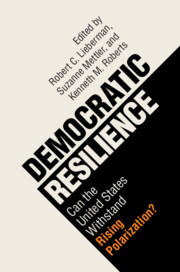Book contents
- Democratic Resilience
- Democratic Resilience
- Copyright page
- Dedication
- Contents
- Figures
- Tables
- Contributors
- Acknowledgments
- Part I Why Might Polarization Harm Democracy?
- Part II Political Institutions in Polarized Times
- 4 Crosscutting Cleavages, Political Institutions, and Democratic Resilience in the United States
- 5 Unilateralism Unleashed?
- 6 Court-Packing and Democratic Erosion
- Part III Social Polarization and Partisanship
- Part IV Vicious Circles? The Relationship between Polarized Behavior and Institutions
- Part V Can Political Action Save Democracy in Polarized Times?
- Index
5 - Unilateralism Unleashed?
Polarization and the Politics of Executive Action
from Part II - Political Institutions in Polarized Times
Published online by Cambridge University Press: 20 November 2021
- Democratic Resilience
- Democratic Resilience
- Copyright page
- Dedication
- Contents
- Figures
- Tables
- Contributors
- Acknowledgments
- Part I Why Might Polarization Harm Democracy?
- Part II Political Institutions in Polarized Times
- 4 Crosscutting Cleavages, Political Institutions, and Democratic Resilience in the United States
- 5 Unilateralism Unleashed?
- 6 Court-Packing and Democratic Erosion
- Part III Social Polarization and Partisanship
- Part IV Vicious Circles? The Relationship between Polarized Behavior and Institutions
- Part V Can Political Action Save Democracy in Polarized Times?
- Index
Summary
Having just fought a war to free themselves from the tyrannical grip of George III, few of the delegates to the constitutional convention shared Alexander Hamilton’s enthusiasm for a strong presidency. When James Wilson initially proposed “a single magistrate, as giving most energy dispatch and responsibility to the office,” Edmund Randolph denounced the plan as “the foetus of monarchy.” Wilson’s ideas would eventually win out, but the presidency became one of the most controversial features of the new Constitution during the ratification debates. In his fifth letter, the anti-federalist writer Cato warned that “inexplicitness seems to pervade this whole political fabric,” particularly regarding the limits on the powers of the executive magistrate. Without precise limits, Cato warned, “you might as well deposit the important powers of legislation and execution in one or a few and permit them to govern according to their disposition and will.”
- Type
- Chapter
- Information
- Democratic ResilienceCan the United States Withstand Rising Polarization?, pp. 118 - 140Publisher: Cambridge University PressPrint publication year: 2021

